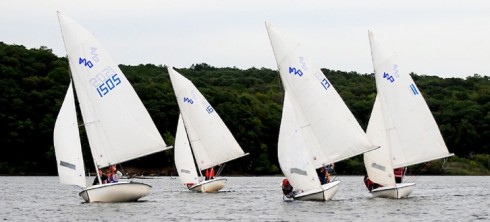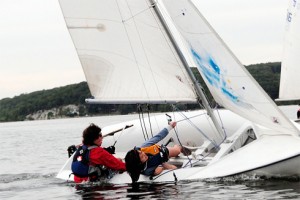Wesleyan Sailing Goes from Club-Sport to Competition

Three times a week, a group of Wesleyan sailors travel 21 miles to Essex, Conn. for a three-hour practice on the Connecticut River. On the weekends, the students tackle the waters in New Hampshire, Massachusetts, Vermont or Maine.
The Wesleyan Sailing Team, which recently completed its second year participating in the competitive New England Intercollegiate Sailing Association (NEISA), finished its season in 26th place. Forty-two collegiate teams are registered with NEISA.
This fall, the student-run group competed in nine regattas and 10 last spring. They finished three ranks under Amherst College, one rank under Middlebury College and four ranks above Williams College.
“We started at the very bottom, so we’re satisfied with 26th,” says Wesleyan Sailing Team member Jacon Mayer ’10. “Next year the team is hoping to be five spots higher.”
Mayer, who transferred to Wesleyan during his sophomore year, was instrumental in transforming the hobby-driven club into a competitive sport. He and other teammembers recruited a handful of dedicated first- and second-year students willing to put in the time and effort needed to compete.

Wesleyan sends two teams, each with a “skipper” and “crew,” to a regatta. The team has seven competitive pairs that have competed this semester. The sailors use the host school’s fleet, and the schools alternate boats each race.
“We put in the same amount of time as varsity athletes,” Mayer says. “We would like to get to a stage where we are competitive enough to get into the post-season.”
The team credits their jump in ranking to their new coach, Tyler Burd, who joined the team last spring. A recent graduate and former captain of the Colgate University Sailing Team, Burd also is familiar with the intricacies of running a competitive college sailing team.
“The club is doing very well at the moment,” Burd says. “The team is growing every season and everyone is really committed to helping us grow and improve. We are also have a lot of underclassmen, which is great in terms of establishing ourselves in the future.”
Burd would like to see the team continue to maintain its aggressive regatta schedule and sail in even more events.
“The more sailing we do the better our members become,” he says.
Wesleyan Sailing completed its 2009 season Nov. 1 at the University of New Hampshire’s Underdog Trophy challenge for lower-tier teams. In one fleet, Angus Page ’12 and Caroline Eisenmann ’12 scored 77 points for sixth place. In another fleet, Mayer and Rebecca Vaadia ’13 scored 101 points for seventh place. The team’s complete roster is online.
The team will begin the 2010 season with “frostbite” racing in January. Regular sailing practice will resume in March, and if all goes, well, the team will sail from a new venue.
Since 1988, the Wesleyan Sailing Team has practiced, and stored its fleet at the Pettipaug Yacht Club of Essex. They’re eying a new location at Lake Pocotopaug in East Hampton, Conn., a location only 10 miles away.
“Now that we’re competing at a high level, we need to be in a place closer to campus that has more space and wind,” Mayer says. “Also, the current on the Connecticut River is difficult to train on.”
Wesleyan Sailing also hopes to raise funds for a new fleet through their Wesleyan Sailing Fleet Renewal Project. They’re currently sailing on six 420-class dinghies, built in the 80s. In the months ahead, the team will ask the support of the larger Wesleyan community in order to raise fund to build the new fleet.
“I’ll be graduating, but my goal is to help Wesleyan Sailing create enough of an infrastructure that it will continue to develop after I leave,” Mayer says.

